Almond Flour Pancakes
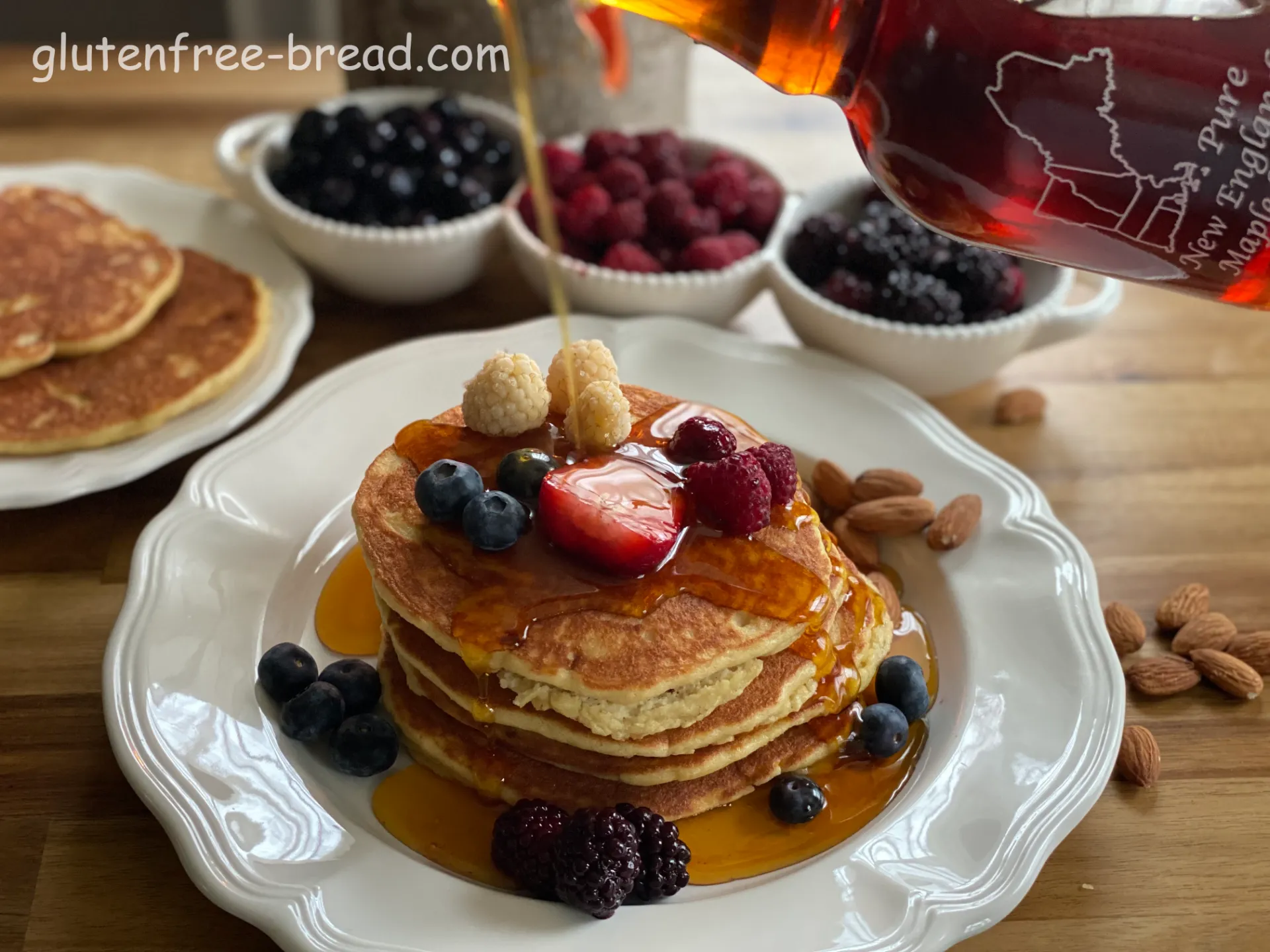
Ingredients:
| Name | Metric | US | TIP | |
|---|---|---|---|---|
| Blanched Almond Flour | 100 gr | 1 cup | ||
| Banana, small | 1 | 1 | ||
| Eggs | 2 | 2 | ||
| Milk | 60 ml | 1/4 cup | ||
| Baking Powder | 6 gr | 1 teaspoon | ||
| Salt | 3 gr | 1/2 teaspoon |
Optional Ingredients :
| 3 gr / 1/2 tsp Cinnamon | |
| 3 gr / 1/2 tsp Vanilla |
Equipment:
| Hand mixer or blender |
Steps:
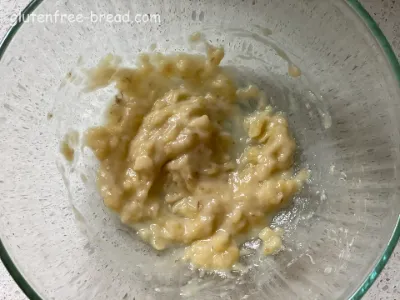
Step 1
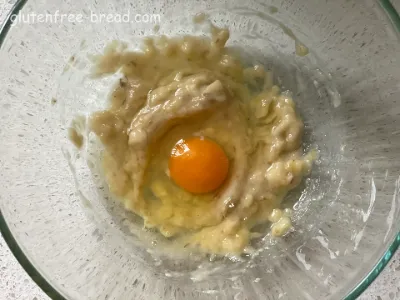
Step 2
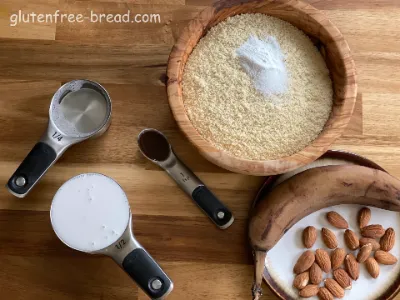
Step 3
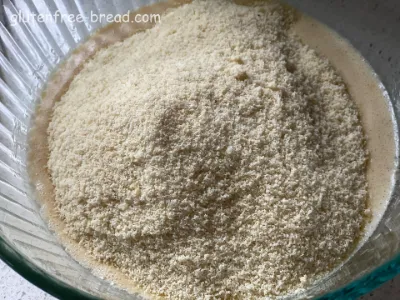
Step 4
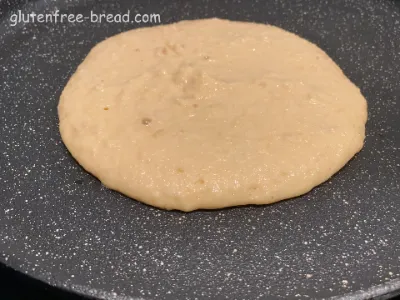
Step 5
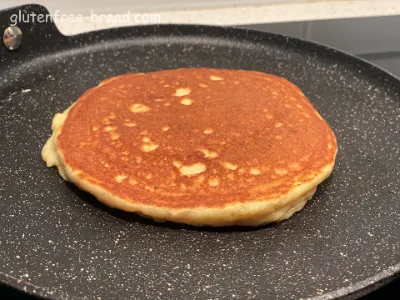
Step 6
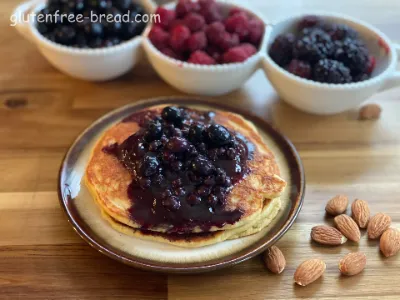
Step 7
Notes:

Almond Flour Pancakes
Working with almond flour can indeed be a bit different from traditional wheat flour due to its unique properties. Here are some aspects to consider and tips for working with almond flour:
Absorbency and Texture:
- Almond flour is more absorbent than wheat flour, which means it can make batters and doughs thicker. Adjusting the liquid content in recipes is crucial to achieve the desired consistency.
- It also lacks gluten, so it doesn't stretch and bind like wheat flour. This can affect the texture of baked goods, making them more delicate and prone to crumbling.
Moisture Content:
- Almond flour contains natural oils from almonds, which can affect the moisture content of your baked goods. This may require adjustments in baking time and temperature to ensure even baking and avoid drying out.
Baking Properties:
- Almond flour tends to brown more quickly than wheat flour due to its higher fat content. Keep an eye on baked goods made with almond flour to prevent over-browning.
- For recipes that require rising agents like baking powder or baking soda, almond flour can produce denser results compared to wheat flour. Adding additional leavening agents or incorporating whipped egg whites can help achieve a lighter texture.
Binding Agents:
- Due to the lack of gluten, almond flour may require additional binding agents such as eggs or xanthan gum in recipes like pancakes, cookies, or cakes to help hold the ingredients together.
Storage and Shelf Life:
- Store almond flour in a sealed container in the refrigerator or freezer to maintain freshness and prevent it from becoming rancid due to its high-fat content.
- Bring almond flour to room temperature before using it in recipes to ensure accurate measurements and consistent results.
Recipes and Substitutions:
- Almond flour can often be substituted for wheat flour in gluten-free and low-carb recipes. However, it may not be a one-to-one substitution due to its unique characteristics. Experimentation may be needed to adjust quantities and ingredients for optimal results.
Texture and Flavor:
- Baked goods made with almond flour tend to have a denser, moister texture and a slightly nutty flavor. Embrace these qualities to create delicious and unique treats that highlight the natural taste of almonds.
In summary, while almond flour offers a nutritious and flavorful alternative to traditional wheat flour, it requires some adjustments and considerations when baking. With practice and experimentation, you can master working with almond flour and enjoy creating a variety of delicious gluten-free and low-carb baked goods.
Tips for cooking pancakes to ensure they turn out fluffy, evenly cooked, and delicious:
Preheat the Pan: Make sure your skillet or griddle is well-heated before adding the pancake batter. A medium-low to medium heat is usually ideal to prevent burning while ensuring thorough cooking.
Use a Non-Stick Surface: If possible, use a non-stick skillet or griddle. This reduces the need for excessive oil and helps pancakes release easily.
Lightly Grease the Pan: Before cooking each batch of pancakes, lightly grease the cooking surface with butter, oil, or cooking spray. Use a paper towel to spread the oil evenly and remove any excess.
Pour Evenly: Use a ladle or measuring cup to pour the pancake batter onto the skillet. Pour from the center outwards to help maintain a round shape.
Wait for Bubbles: Let the pancake cook undisturbed until bubbles form on the surface and the edges start to look set. This usually takes about 2-3 minutes.
Flip Carefully: Use a thin spatula to flip the pancake gently. Cook the other side for another 1-2 minutes, or until golden brown.
Avoid Pressing Down: Resist the urge to press down on the pancakes with the spatula while cooking. This can deflate them and make them less fluffy.
Keep Warm: If you're making multiple batches, keep cooked pancakes warm by placing them on a baking sheet in a low oven (around 200°F or 90°C) while you finish cooking.
Serve Fresh: Serve pancakes immediately for the best taste and texture. Top with your favorite toppings like butter, maple syrup, fresh fruit, or whipped cream.
By following these tips, you'll be able to make perfect pancakes every time, whether you're using traditional wheat flour or alternative flours like almond flour or oat flour. Enjoy your pancakes!
Almond Flour Pancakes additional information:
Baking powder plays a crucial role in pancake batter by contributing to its texture, fluffiness, and rise during cooking. Here's how baking powder functions and its importance in pancake batter:
Leavening Agent:
- Baking powder is a leavening agent that produces carbon dioxide gas when mixed with wet ingredients in the batter.
- The carbon dioxide gas forms bubbles throughout the batter, causing it to expand and rise when exposed to heat.
Fluffiness and Texture:
- The release of carbon dioxide gas from the baking powder creates air pockets within the pancake batter.
- This aeration gives pancakes a light and fluffy texture, making them soft and tender when cooked.
Rise and Volume:
- Baking powder helps pancakes to rise and achieve a desirable thickness or height as they cook on the griddle or skillet.
- Without baking powder or a similar leavening agent, pancakes would be dense and flat, lacking the characteristic lightness and volume.
Ease of Cooking:
- The bubbles formed by baking powder help distribute heat evenly throughout the pancake batter.
- This even distribution of heat ensures that pancakes cook evenly, with a golden brown exterior and a properly cooked interior.
Controlled Reaction:
- Baking powder is a balanced mixture of an acid (usually cream of tartar) and a base (typically baking soda).
- This balanced composition ensures a controlled release of carbon dioxide gas when mixed with moisture, providing consistent and predictable results in pancake baking.
In summary, baking powder is essential in pancake batter for its leavening properties, which contribute to the pancakes' fluffiness, rise, and overall texture. It ensures that pancakes are light, airy, and enjoyable to eat, making it a key ingredient in pancake recipes worldwide.
Salt plays a crucial role in pancake batter and other baked goods, contributing to both the flavor and texture of the final product. Here are the key reasons why salt is important in pancake batter:
Flavor Enhancement:
- Salt enhances the overall flavor profile of pancakes by balancing sweetness and bringing out other flavors.
- Even in sweet pancakes, a small amount of salt helps to highlight the natural flavors of the ingredients, making them more pronounced and enjoyable.
Balance of Sweetness:
- In pancake batter, which typically includes ingredients like sugar or other sweeteners, salt helps to balance out the sweetness.
- This balance is crucial for achieving a harmonious taste that is neither overly sweet nor bland.
Texture Regulation:
- Salt plays a role in regulating the gluten formation in pancake batter, especially when using wheat flour.
- It helps to strengthen the gluten strands, contributing to a more structured and stable batter that holds together well during cooking.
Browning and Crispiness:
- Salt can influence the browning reaction (Maillard reaction) during cooking, which contributes to the golden brown color and crispy exterior of pancakes.
- It also affects the texture of the cooked pancakes, ensuring they are tender yet firm.
Preservation and Shelf Life:
- Salt acts as a natural preservative in pancake batter, helping to extend the shelf life by inhibiting the growth of bacteria and mold.
- While not a significant factor in cooked pancakes, it contributes to the overall stability of the batter before cooking.
Overall Balance:
- Beyond flavor and texture, salt plays a role in achieving a balanced batter consistency and performance.
- It ensures that the ingredients in the batter mix uniformly and that the pancakes cook evenly with a pleasing mouthfeel.
In conclusion, while salt may seem like a small component in pancake batter, its role is essential for enhancing flavor, balancing sweetness, regulating texture, and ensuring overall quality. Adjusting salt levels according to personal taste preferences can help achieve the perfect pancake every time.
Almond flour, also known as almond meal or ground almonds, is made from finely ground almonds with the skins on. Here's a detailed overview of almond flour:
Origin and Processing:
- Almond flour is typically made by grinding blanched almonds (almonds without their skins) into a fine powder. Some varieties include the skins, resulting in a coarser texture and slightly nuttier flavor.
- It can be homemade by grinding whole almonds in a food processor until fine, but commercially produced almond flour is more finely ground and consistent in texture.
Nutritional Benefits:
- High in Protein: Almond flour is rich in protein, making it a suitable option for those looking to increase their protein intake.
- Low in Carbohydrates: It is lower in carbohydrates compared to wheat flour, making it a popular choice for low-carb and keto diets.
- Healthy Fats: Almond flour contains healthy monounsaturated fats, which are beneficial for heart health.
- Rich in Vitamins and Minerals: It provides significant amounts of vitamin E, magnesium, and manganese.
Culinary Uses:
- Gluten-Free Baking: Almond flour is a staple in gluten-free and grain-free baking. It adds moisture and a slightly nutty flavor to baked goods.
- Breading and Coatings: It can be used as a gluten-free alternative for breading meats and vegetables.
- Thickening Agent: Almond flour can be used as a thickener in sauces and soups, similar to how wheat flour or cornstarch is used.
Flavor Profile:
- Almond flour has a mild, nutty flavor that adds a pleasant taste to dishes. It is slightly sweet and enhances the overall flavor of baked goods.
Health Considerations:
- While almond flour is nutritious, it is calorie-dense, so portion control is important, especially for those watching their calorie intake.
- It's also important to note that almond flour doesn't behave the same way as wheat flour in baking due to its lack of gluten, so recipes may need adjustments in terms of liquid content and leavening agents.
In summary, almond flour is a versatile and nutritious alternative to traditional flours, prized for its rich flavor, high protein content, and suitability for gluten-free diets. Its use has become increasingly popular in both home and professional kitchens for a variety of culinary applications.
The main difference between almond flour and almond meal lies in their texture and how they are processed:
Texture:
- Almond Flour: Almond flour is typically made from blanched almonds (almonds without their skins) that are finely ground into a flour-like consistency. It has a finer texture similar to traditional wheat flour.
- Almond Meal: Almond meal is made from almonds that are ground with their skins still intact, resulting in a coarser texture compared to almond flour. It may have small pieces of almond skin visible in the mixture.
Processing:
- Almond Flour: The almonds used for almond flour are usually blanched (briefly boiled and then peeled) to remove the skins before grinding. This process results in a lighter color and finer texture.
- Almond Meal: Almond meal is made by grinding whole almonds, including the skins. This process retains more of the natural oils and nutrients found in the almonds, but it also gives it a coarser texture and slightly darker color.
Culinary Uses:
- Almond Flour: Due to its finer texture, almond flour is commonly used in baking recipes where a smoother texture is desired, such as cakes, cookies, and muffins. It blends well into batters and doughs, providing a lighter and more delicate crumb.
- Almond Meal: Almond meal's coarser texture makes it suitable for recipes where a more rustic or crunchy texture is desired, such as in crusts for pies or tarts, coatings for meats and fish, and as a topping for baked goods.
Nutritional Content:
- Both almond flour and almond meal retain the nutritional benefits of almonds, including healthy fats, protein, fiber, vitamins, and minerals. The difference in texture does not significantly affect their nutritional value.
In summary, while almond flour and almond meal are both made from almonds and offer similar nutritional benefits, their main distinction lies in texture and how they are processed. Almond flour is finer and made from blanched almonds, while almond meal is coarser and includes the almond skins. The choice between almond flour and almond meal in recipes often depends on the desired texture and outcome of the dish.
Making almond flour at home is straightforward and requires just a few steps. Here’s how you can make almond flour using blanched almonds:
Ingredients:
- Blanched almonds (almonds without skins)
Equipment:
- Food processor or high-speed blender
Instructions:
Prepare the Almonds:
- Start with blanched almonds, which are almonds that have had their skins removed. You can either purchase blanched almonds or blanch whole almonds yourself by briefly boiling them and then removing the skins.
Dry the Almonds (Optional):
- If your blanched almonds are wet from blanching, pat them dry with a clean kitchen towel or paper towel. It's important for the almonds to be dry before grinding to prevent clumping.
Grind the Almonds:
- Place the blanched almonds in a food processor or high-speed blender. You can start with a smaller batch if your appliance has a smaller capacity.
- Pulse the almonds in short bursts until they are finely ground. Be careful not to over-process, as this can turn the almonds into almond butter rather than flour.
Sift (Optional):
- If you want a finer almond flour, you can sift the ground almonds through a fine-mesh sieve to remove any larger pieces or almond skins that weren't fully ground.
Store Almond Flour:
- Transfer the almond flour to an airtight container or jar and store it in a cool, dry place. Homemade almond flour can be kept for several weeks to a few months, depending on storage conditions.
Tips:
- Batch Size: Process smaller batches at a time to ensure even grinding and prevent the motor of your food processor or blender from overheating.
- Storage: Store almond flour in the refrigerator or freezer for longer shelf life, especially in warmer climates.
- Use: Use homemade almond flour as a gluten-free alternative in baking recipes, pancakes, coatings for meats, or as a thickening agent in sauces.
By making almond flour at home, you can control the texture and freshness of the flour, ensuring it meets your specific culinary needs and preferences. Enjoy using your homemade almond flour in a variety of delicious recipes!
Pancakes come in a wide variety of forms and flavors around the world, each reflecting local ingredients, traditions, and culinary techniques. Here are some popular pancake varieties from different cultures:
American Pancakes:
- Thick, fluffy pancakes made with a batter of flour, eggs, milk (or buttermilk), and baking powder.
- Typically served stacked and topped with butter, maple syrup, fresh berries, or whipped cream.
- Variations include adding chocolate chips, bananas, or blueberries to the batter.
French Crepes:
- Thin pancakes made from a batter of flour, eggs, milk, and sometimes butter.
- Cooked on a hot griddle or skillet and served folded or rolled with sweet fillings like Nutella, jam, fresh fruit, or savory fillings like cheese, ham, or spinach.
Russian Blini:
- Thin, yeast-leavened pancakes traditionally made with buckwheat flour.
- Served with sour cream, butter, caviar, smoked salmon, or a variety of sweet toppings like honey, jam, or condensed milk.
Japanese Okonomiyaki:
- Savory Japanese pancakes made with cabbage, flour, eggs, and dashi (Japanese soup stock).
- Cooked on a griddle and often filled with ingredients like pork belly, shrimp, squid, or vegetables.
- Topped with okonomiyaki sauce, mayonnaise, bonito flakes, and seaweed flakes.
Indian Dosas:
- Thin, crispy South Indian pancakes made from fermented rice and lentil batter (urad dal).
- Cooked on a griddle and served with coconut chutney and sambar (spicy lentil soup).
- Variations include masala dosa, filled with a spiced potato filling.
Chinese Scallion Pancakes:
- Flaky, savory pancakes made from a dough of flour, water, and chopped scallions.
- Rolled thin, brushed with oil, and folded several times before frying until crispy.
- Served with dipping sauces like soy sauce or hoisin sauce.
Mexican Hotcakes (Hotcakes Mexicanos):
- Thick and fluffy Mexican pancakes made with flour, eggs, milk, and often sweetened with vanilla and cinnamon.
- Served with toppings like caramel sauce (cajeta), fresh fruit, or whipped cream.
Dutch Poffertjes:
- Miniature, fluffy pancakes made from a batter of yeast, flour, milk, and eggs.
- Cooked in a special cast iron pan with small indentations and served with powdered sugar and butter.
These are just a few examples of the diverse world of pancakes. Each variety offers a unique taste experience and showcases the cultural diversity and creativity in pancake-making traditions globally.
Pancakes are incredibly versatile and can be paired with a wide range of toppings and accompaniments, depending on personal preferences and cultural influences. Here are some popular and delicious pairings for pancakes:
Sweet Toppings:
- Maple Syrup: A classic choice that complements the mild sweetness of pancakes with its rich, caramel-like flavor.
- Fresh Fruits: Sliced bananas, strawberries, blueberries, raspberries, or mixed berries add freshness, juiciness, and a burst of flavor.
- Whipped Cream: Adds a light and creamy texture, often combined with fruits or syrups for extra indulgence.
- Chocolate or Caramel Sauce: Drizzling with chocolate or caramel sauce adds a decadent touch to pancakes, perfect for chocolate lovers.
- Powdered Sugar: A simple dusting of powdered sugar enhances sweetness and adds a delicate finish.
Savory Options:
- Eggs: Serve pancakes alongside scrambled eggs, poached eggs, or sunny-side-up eggs for a balanced breakfast with protein.
- Bacon or Sausage: The savory saltiness of bacon or sausage complements the sweetness of pancakes, creating a satisfying contrast.
- Avocado: Slices of ripe avocado add creaminess and a healthy fat component to balance out the sweetness.
- Cheese: Soft cheeses like ricotta or cream cheese can be spread on pancakes, topped with fruit or honey for a savory-sweet combination.
- Smoked Salmon: A luxurious option, smoked salmon pairs well with cream cheese and fresh herbs on pancakes for a savory brunch twist.
Other Toppings:
- Nuts: Chopped nuts such as almonds, pecans, or walnuts add crunch and texture, enhancing both sweet and savory pancakes.
- Yogurt: Greek yogurt or flavored yogurt can be served alongside pancakes, offering a creamy and tangy contrast.
- Honey or Agave Nectar: Provides a natural sweetness that complements pancakes, particularly when combined with fruits or nuts.
- Ice Cream: For a decadent dessert, serve warm pancakes topped with a scoop of vanilla or flavored ice cream.
Global Flavors:
- Nut Butters: Peanut butter, almond butter, or other nut spreads add richness and protein, perfect for a hearty breakfast.
- Coconut: Shredded coconut or coconut flakes add tropical sweetness and texture to pancakes.
- Spices: Cinnamon, nutmeg, or cardamom can be sprinkled over pancakes for added warmth and flavor.
Ultimately, the best pairing for pancakes depends on personal taste preferences and whether you prefer sweet or savory flavors. Experimenting with different toppings and combinations can add variety and excitement to your pancake experience, making them suitable for any meal of the day.







